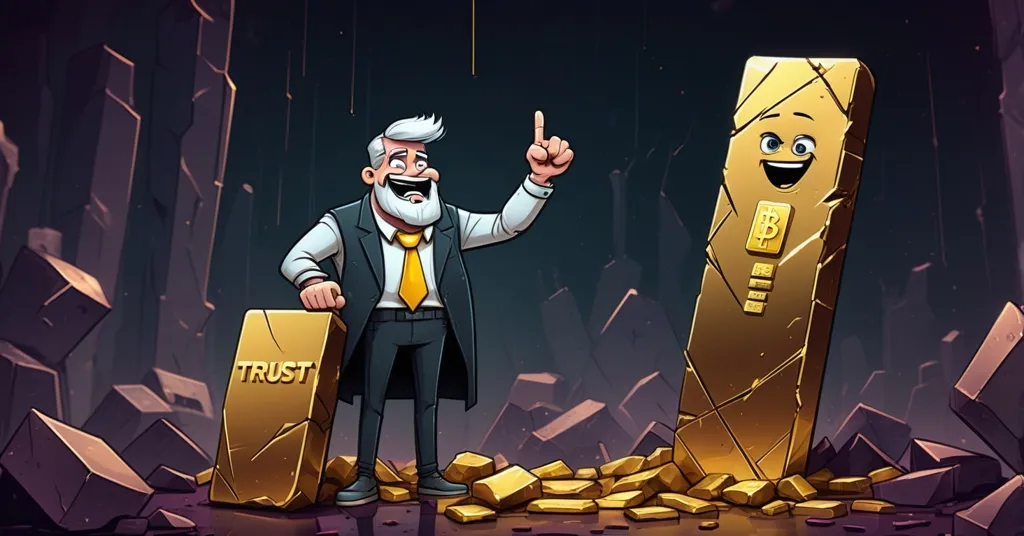CZ Slams Schiff’s Tokenized Gold as ‘Trust Me Bro’ Amid Gold Price Crash

CZ Calls Tokenized Gold a ‘Trust Me Bro’ Token as Peter Schiff Faces Gold Price Crash
Changpeng Zhao (CZ), the founder and former CEO of Binance, has unleashed a scathing critique of Peter Schiff’s newly announced tokenized gold product, branding it a “trust me bro” token that fails to embody the decentralized spirit of blockchain technology. As Schiff, a die-hard gold advocate and Bitcoin skeptic, tries to modernize gold with blockchain, CZ’s sharp words—paired with gold’s recent price nosedive—cast serious doubt on whether such hybrid assets can truly disrupt traditional markets or if they’re just old finance in a shiny new wrapper.
- CZ’s Take: Tokenized gold is centralized, relying on risky custodians who could collapse under pressure.
- Schiff’s Blunder: Gold crashes below $4,100, mocking his $6,000 by Christmas 2025 prediction.
- Bitcoin Holds Firm: BTC climbs 1.17% to $109,629, showing resilience amid market chaos.
The Irony of Schiff’s Blockchain Pivot
Peter Schiff has long been the poster child for gold bugs, relentlessly criticizing Bitcoin as a speculative fad destined for collapse while championing gold as the ultimate safe haven. His recent announcement of a tokenized gold product—a digital version of physical gold built on blockchain for easier ownership and transfer—feels like a twist straight out of a bad crypto sitcom. Here’s a guy who’s spent years bashing the very technology he’s now embracing, and the crypto community isn’t letting that irony slide. But before anyone could fully digest Schiff’s about-face, CZ stepped in with a verbal knockout, exposing the deep flaws in tokenized gold and reigniting the Bitcoin vs. gold debate.
What Is Tokenized Gold, and Why the Controversy?
For those just dipping their toes into the crypto pool, tokenized gold is a digital representation of physical gold, recorded on a blockchain. Think of it as a digital IOU tied to real gold bars supposedly stored in a vault somewhere. The pitch is simple: it combines gold’s perceived stability with blockchain’s speed and accessibility, allowing fractional ownership and instant transfers without needing a physical safe. Sounds neat, right? Not so fast. The catch lies in who holds the actual gold—a centralized custodian, often a third-party company or bank. You don’t own the gold directly; you own a promise that someone else has it for you. And as CZ points out, that’s where the tokenized gold risks start piling up.
CZ argues that this setup is the antithesis of blockchain’s core promise: decentralization. Unlike Bitcoin, where on-chain ownership means your assets are recorded directly on a public ledger, verifiable by anyone without a middleman, tokenized gold keeps you tethered to a centralized entity. A trustless system—one that relies on code and math instead of human intermediaries—is nowhere to be found here. Instead, you’re stuck hoping the custodian doesn’t go bankrupt, get hacked, or have their vaults seized in a geopolitical crisis. In short, it’s a half-assed compromise that inherits the worst of both worlds: the opacity of traditional finance and the complexity of blockchain without the full benefits of either.
“trust me bro token”
That’s CZ’s brutal summation of tokenized gold—a phrase that cuts straight to the lack of trustless security. His skepticism isn’t just hot air; it’s rooted in the crypto world’s painful history of centralized failures. From the Mt. Gox debacle, where thousands lost their Bitcoin due to poor custodianship, to countless DeFi scams and rug pulls, we’ve seen what happens when you rely on third parties. Tokenized gold doesn’t eliminate that risk; it just repackages it with a blockchain bow. What happens if the issuer folds? What if a government confiscates the physical gold during an economic meltdown? These aren’t far-fetched scenarios—they’re the kind of real-world messes that Bitcoin was built to sidestep. For more on CZ’s perspective, check out his thoughts on why tokenized gold struggles to gain traction.
Schiff’s Catastrophic Misjudgment on Gold Prices
Schiff’s timing for hyping tokenized gold couldn’t be more disastrous. On October 22, 2025, gold prices tanked below $4,100, marking a record low that laughs in the face of his bullish forecast of $6,000 by Christmas 2025. That’s not just a miss; it’s a catastrophic misjudgment that’s left him open to ridicule. Veteran crypto trader Peter Brandt didn’t hold back, poking at Schiff with data showing gold’s underwhelming historical performance. Over the past 45 years, gold has averaged a paltry 3.6% annual return, often stuck in deep, drawn-out consolidations. For an asset pitched as the ultimate store of value, those numbers are downright embarrassing.
Meanwhile, Bitcoin, despite its wild swings, is quietly flexing. In the last 24 hours, BTC notched a 1.17% uptick to $109,629. Sure, it’s not a moonshot, but it’s a stark contrast to gold’s faceplant. Looking longer term, Bitcoin’s annualized returns over the past decade have consistently trounced gold, often by double-digit multiples. Why? Because Bitcoin isn’t just a store of value; it’s the hardest money ever created, backed by math, scarcity, and a network that doesn’t care about custodians or government whims. You hold your private keys, you hold your wealth—period. No “trust me bro” required.
The Flaw in Tokenizing Traditional Assets
Schiff’s stumble isn’t just a personal L; it’s emblematic of traditional finance’s awkward tango with decentralization. Tokenized gold represents a broader attempt to drag legacy assets into the blockchain era, but it exposes a fundamental flaw: you can’t slap a decentralized label on something that’s still chained to centralized trust. Blockchain’s power lies in cutting out intermediaries, creating systems where code is law. Bitcoin embodies that with every transaction verified by a global network of nodes. Tokenized gold? It’s just a digital promise from a stranger you’ve never met, dressed up in tech jargon.
History backs up CZ’s concerns. Early tokenized gold projects like DigixDAO, launched in 2016, promised to link Ethereum tokens to physical gold reserves. It sounded revolutionary but fizzled out due to custodial trust issues, high fees, and regulatory roadblocks. Pax Gold, another attempt, still struggles with transparency around its reserves and hasn’t captured mainstream traction. These flops highlight why Schiff’s venture is likely dead on arrival for crypto natives who value trustlessness above all. Without true on-chain ownership or decentralized custodianship, tokenized assets remain a gimmick—a shiny distraction from the real disruption happening with Bitcoin and beyond.
Bitcoin’s Quiet Resilience and Maximalist Edge
As gold flounders, Bitcoin’s resilience isn’t just a flex—it’s a reminder of why decentralization matters. BTC isn’t perfect; its volatility can make even the staunchest HODLer sweat. But its design as a trustless, borderless, censorship-resistant form of money gives it an edge no traditional asset can match. Over the past decade, Bitcoin has delivered annualized returns averaging over 100% in some periods, dwarfing gold’s measly 3.6%. More importantly, it’s survived every attempt to kill it—from government bans to market crashes—because it doesn’t rely on a single point of failure. No custodians, no empty promises, just pure, unadulterated math.
As a Bitcoin maximalist, I’ll argue BTC doesn’t need to play nice with gold or any legacy asset. It’s already the king of hard money, a digital fortress that laughs at inflation and centralized control. But I’ll tip my hat to altcoins and other blockchains like Ethereum, which have carved out niches in tokenizing real-world assets through smart contracts. These experiments, while often flawed, push boundaries and test what’s possible. The catch? They must avoid replicating the broken trust models of the past, or they’re just pointless noise in the signal of decentralization.
Playing Devil’s Advocate: Could Tokenized Gold Have a Niche?
Let’s not write off tokenized gold entirely—yet. There’s a sliver of potential for it to serve a niche, especially for traditional investors who want gold exposure without the hassle of physical storage. Imagine retirees or hedge funds using tokenized gold as a convenient entry point into blockchain tech, maybe even as a stepping stone to understanding Bitcoin. It could also play a role in DeFi as a gold-backed stablecoin, offering stability for decentralized trading without the wild swings of pure crypto.
But here’s the rub: custodial risks remain a dealbreaker. Even with advancements like proof-of-reserve mechanisms—where custodians publicly audit their gold holdings on-chain—or oracles feeding real-time data into smart contracts, you’re still trusting someone to not screw you over. Crypto OGs will likely reject it outright, and rightfully so. Unless tokenized gold evolves into a truly decentralized model, it’s just old wine in a new bottle—a compromise that fails to capture the revolutionary spark of blockchain.
Key Takeaways and Questions to Ponder
- What is tokenized gold, and why is it so divisive?
It’s a digital token tied to physical gold on a blockchain, meant to ease trading and ownership. The divide comes from its centralized reliance on custodians, clashing with blockchain’s trustless ethos as CZ sharply critiques. - Why does CZ slam tokenized gold as a failure?
He sees it as a betrayal of decentralization, more akin to a shaky promise than a true blockchain asset, with risks like issuer bankruptcy or hacks making it a non-starter. - How does Schiff’s gold price flop hurt his credibility?
Predicting $6,000 by Christmas 2025 while gold sinks below $4,100 makes him look clueless, especially as critics like Peter Brandt highlight gold’s dismal returns and Bitcoin edges up. - Is there any hope for tokenized gold in the crypto space?
Maybe as a niche for traditional investors or DeFi stablecoins, but only if custodial risks are slashed—otherwise, it’s just repackaged centralized nonsense. - What does this clash reveal about blockchain’s bigger picture?
It underscores the tension between integrating traditional assets into decentralized systems and preserving blockchain’s trustless core, raising questions about whether hybrids like tokenized gold can ever match Bitcoin’s disruptive punch.
Tokenized Gold and the Acceleration of Disruption
CZ’s “trust me bro” jab isn’t just a meme; it’s a wake-up call for the entire tokenized asset space. If blockchain is going to dismantle the status quo—and I’m all in on that bet—then half-baked ideas like Schiff’s need to either level up or step aside. Bitcoin didn’t rewrite the rules of money by compromising on decentralization, and neither should the next wave of innovation. That said, even flawed experiments like tokenized gold contribute to the grind of progress. They push boundaries, expose weaknesses, and accelerate the shift to decentralized systems, whether Schiff likes it or not. That’s effective accelerationism (e/acc) in action—full speed ahead, damn the torpedoes.
Schiff may be down with gold’s crash and his tokenized misadventure, but don’t count him out. Gold bugs are a stubborn breed, and he’ll likely double down. Still, with Bitcoin holding steady and the crypto community smelling blood, the scoreboard isn’t favoring team yellow metal. Will tokenized gold ever shed its centralized baggage, or is Bitcoin the only true disruptor? The jury’s still out, but I know where I’m placing my chips.



